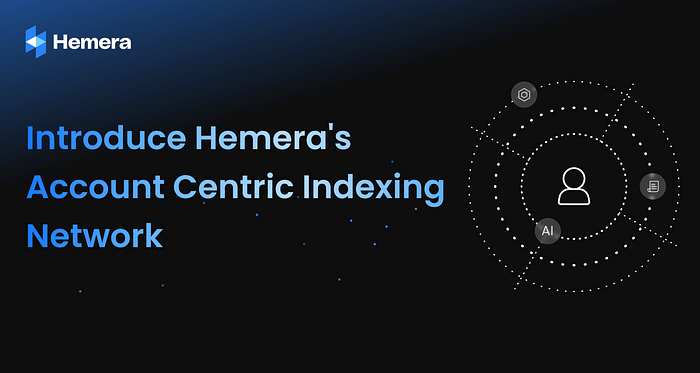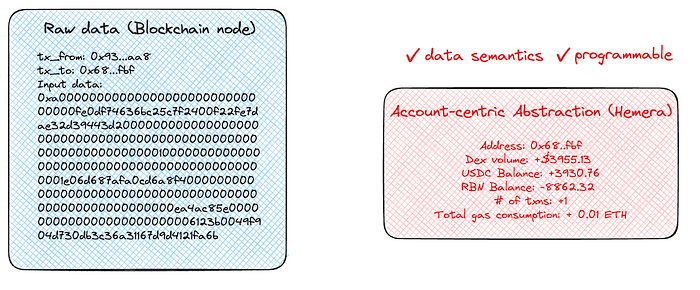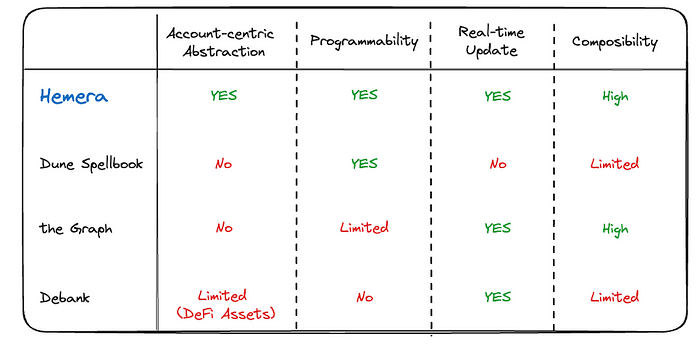Introduce Hemera’s Account-Centric Indexing Network

Challenges and Opportunities
Recently, we've observed two significant trends in the blockchain space:
Firstly, as blockchain ecosystems and applications proliferate, individual accounts are engaging in increasingly diverse and complex on-chain activities. This results in more comprehensive digital footprints for users. The richness of these on-chain interactions opens up new possibilities, such as building on-chain credit scores based on users' portfolios and transaction histories. Such developments could potentially fuel innovations like under-collateralized lending protocols, mirroring practices common in traditional finance.
Secondly, as the industry matures, projects are becoming more focused on understanding user profiles and assessing user quality when making deliberate airdrop strategies or analyzing potential user bases. However, they face a significant challenge: by design, EVM accounts are primarily transaction triggers rather than comprehensive "bank accounts." This fundamental structure makes it difficult to conduct in-depth, account-based data analysis, hindering projects' ability to gain meaningful insights into their user base.
These trends highlight a growing need for sophisticated tools that can effectively analyze and interpret account-centric data in the blockchain ecosystem. To address this need, Hemera Protocol is developing a next-generation account-centric indexing protocol to standardize account-level data retrieval and feature engineering for developers.
This innovation has been further expanded into an Account-Centric Indexing (ACI) network, ensuring a decentralized approach to data management. By leveraging this network, Hemera offers a robust solution for processing and analyzing blockchain data, making it more accessible and meaningful for various applications and use cases.
What is account-centric abstraction?
When a swap transaction occurs on a blockchain, its raw data doesn't intuitively resemble a "swap." If you retrieve this data directly from a blockchain node, it might look like the blue chart below — a complex array of information that's neither semantic nor easy to analyze. Essentially, it's a record of who sent a transaction, to where, and with what input.
Abstraction is the process of interpreting this unintelligible data into meaningful semantics. In the case of a swap, we're primarily interested in the input and output tokens, their quantities, and the value of the trade. Thus, a typical abstraction for a swap might include key elements such as the sender, buy token, sell token, respective amounts, and the trade's $value.
What's truly important is understanding how these transactions impact your overall profile. For instance, a swap alters your token balances, changes your trading volume, increases your total gas spent, and adds to your number of on-chain interactions.
Hemera encapsulates all these account-level changes in a semantic and standardized format, describing them as features. The red figure right below depicts how this swap transaction affects your account state. With the UDF (User Defined Function) module, intended features can be designed and programmed according to specific needs. This abstraction facilitates easier development and more insightful analysis by presenting complex blockchain data in a more accessible and meaningful way.

How can applications leverage Hemera Protocol?
The process for applications to utilize Hemera for in-depth account-based analysis is pretty straightforward. Applications need only query features from the ACI network. Hemera offers a wide array of built-in features, including frequently-used metrics such as portfolio balance, trading volume, lending collateral, and even social data like Farcaster profiles. These can be easily queried for any account of interest without requiring additional code.
For more specialized needs, Hemera provides a UDF module. This module allows developers to create customized features with minimal coding effort. Thanks to the standardized format, these custom features can be seamlessly integrated with existing ones, facilitating more comprehensive and nuanced analysis.
When features are requested, they are transmitted to the Hemera ACI network. Each indexer in the network is responsible for indexing one or more specific features by querying blockchain raw data. The request side then receives account-centric and semantic abstractions from Hemera, eliminating the need to deal with unintelligible raw data.

How do features update?
Features in the Hemera ecosystem update dynamically in response to on-chain transactions. Every indexer in the ACI network is responsible for indexing specific features. These indexers operate in real-time, constantly listening to on-chain transactions that are relevant to the features they're tracking.

How to create a UDF?
To illustrate the process of building a customized UDF, let's consider OpenSea-related features as an example:
- Feature Definition:
Developers first define specific features (e.g., NFT trading volume, NFT trading collections) and data classes. For instance, an Opensea_Orderclass might include variables such as order_hash(string), offerer (string), recipient(string) and offer(dict).
- Trigger and Function Development:
Next, developers create Triggers that specify which transactions or log events alter the state of the defined features. This step ensures the indexer efficiently captures relevant on-chain transactions and filters data of interest. Then, developers can write their customize logic to update the feature values.
- Query Execution:
Finally, developers run the indexer together with the new UDF and process historical data. Then feature data will be available from database and developer can easily retrieve account-level data from database or query feature value through standard REST API.
For a more detailed guide on implementing UDFs, please refer to our documentation: https://docs.thehemera.com

In essence, each feature is a dynamic entity, constantly updated by on-chain activities. The UDF's role is to interpret raw transaction data, create appropriate triggers, and use these triggers to keep features updated.
Hemera's unique position in the data analytics landscape
To understand Hemera's position in the data sector, it's helpful to compare it with existing popular data analytic tools and protocols. Here are the key differentiators:

- Hemera's core strength lies in its account-centric abstraction
- Dune's Spellbook shares the value of abstraction, abstracting high-level data schemas from raw data. However, it's not account-centric.
- The Graph, while a popular indexing protocol, is smart contract event-centric. It's excellent for decoding data related to smart contracts but lacks abstraction or account-centricity.
- Debank exemplifies account-centric abstraction but focuses heavily on DeFi assets, limiting its scope in the diverse landscape of on-chain activities (e.g. On-chain games record).
2. Hemera offers unparalleled flexibility in data manipulation
- With Hemera users can easily manipulate desired data with minimal coding.
- The Graph allows users to build subgraphs for smart contract data retrieval, but restricts deeper data manipulation.
- Debank provides rigid APIs for asset information queries but lacks programmability.
3. Hemera's approach to data update is proactive and in real-time
- Hemera indexers continuously monitor the blockchain, updating features in real-time through a 'push' mechanism triggered by transactions.
- In contrast, Dune updates data in a 'pull' manner, requiring users to fetch all data from their database to update their own.
4. In the context of Web3 applications, Hemera excels in composability and integration
- Hemera offers a standard format for curated data, simplifying database building and maintenance.
- Dune provides a comprehensive terminal for on-chain data queries within its platform but can be costly for building standalone applications.
- Debank's rigid API structure limits its composability to asset-related data only.
As we look to the future, we anticipate that user profiles will become increasingly central to consumer applications as the industry matures. In this evolving landscape, Hemera's account-level, multi-dimensional data will prove invaluable, enabling more precise and effective user targeting. Furthermore, we foresee a growing synergy between AI models and on-chain data, where Hemera's semantic abstraction capabilities will play a crucial role in making data more digestible for Large Language Models.
Our vision for Hemera is ambitious yet clear: we aim to establish it as the comprehensive data hub for the entire industry. By dramatically lowering barriers to access and utilization, we strive to serve developers, researchers, marketing teams, end-users, AI systems, and beyond. Hemera is poised to become the go-to platform for anyone seeking to harness the power of blockchain data, ultimately making this vital resource accessible and valuable to a wide range of users across the blockchain ecosystem.
Explore Hemera Product Suite:
- Website: https://thehemera.com/
Build on Hemera ACI Network
- Doc: https://docs.thehemera.com
- Github: GitHub — HemeraProtocol/hemera-indexer at pre-release/v0.3.0
Access SocialScan Agent Store
- Website: https://socialscan.io/home
About SocialScan
SocialScan is a community-owned AI reimagining web3 UX through customizable AI agents. Users of SocialScan can participate in activities to improve LLM capabilities, consequently gaining ownership according to their individual contributions. SocialScan is trusted by industry-leading blockchain platforms, including Polygon, Linea, Chainlink, Manta Network, Mantle Network, and ZetaChain. SocialScan was developed by experts from top institutions, including Stanford University, Google, Binance, TikTok, Meta, CMU, Cornell, Tsinghua, NTU, and USTC.
About Hemera Protocol
Hemera Protocol is building the next-generation Account-Centric Indexing (ACI) protocol to power high-performance AI applications. This innovation standardizes account-level data retrieval and excels in tracking user behaviors and assets across multiple chains and dapps. With built-in User-Defined Functions (UDFs) and scalable infrastructure, Hemera provides real-time, low-latency insights, allowing developers to focus on their core business while relying on Hemera for smarter and faster on-chain data handling.
Whitepaper | Website | Twitter | Discord